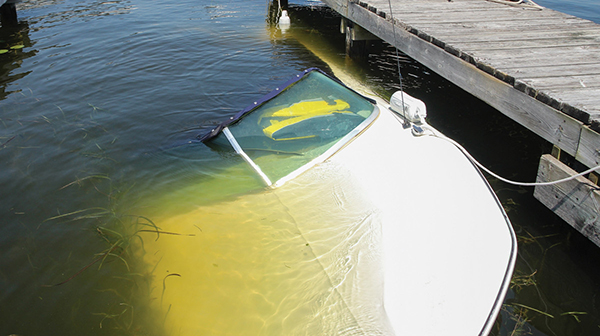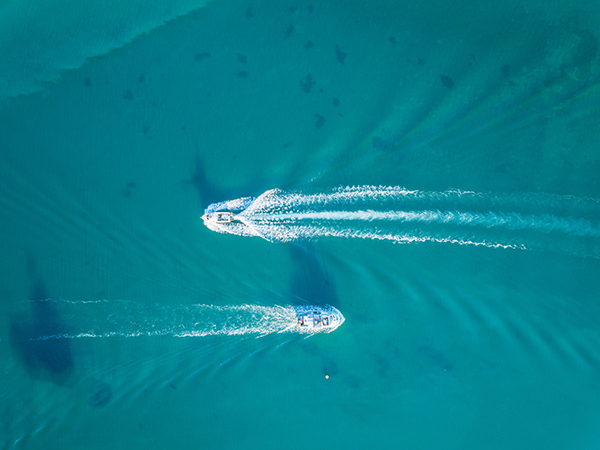While some new boaters might assume that vessels are just like cars, that notion misses some crucial distinctions: Boats don’t have brakes, for one. Boats also don’t navigate on roads with lanes.
So, we all face at least a partial learning curve when we start boating. Even old salts periodically discover some nuance that teaches them a lesson.
If the following 10 common on-water mistakes and faux pas haven’t bitten you yet, maybe this refresher might help you avoid them.
Sink or Swim
Amazingly, a small piece of rubber and metal — the drain plug — is the crucial component keeping your boat afloat at the dock. When you haul out your vessel, you remove the plug and put it somewhere safe or loosen it, depending on which type of plug you use.
Prudent mariners use a checklist every time they launch, and replacing the drain plug tops that worksheet. At the very least, pay attention after you launch; if you see the boat riding low in the water, take quick action.

Weather, Water and Waves
Getting caught in rain might be uncomfortable, but getting caught in a lightning storm can be deadly. Check the marine-weather and the land forecasts when you’re planning an outing or voyage, and keep checking the forecast throughout your day.
On saltwater, be aware of the local tide stages and amplitudes. Many regions feature volatile tidal currents and drastic tide changes that can leave you high and dry on a sandbar or mud flat for hours. When a major tide change pairs with a strong wind, the water can remain out on a low tide (or in on a high tide) longer. Wind against a tide can also dangerously stack up the seas.
Situational Awareness
If you see people ahead of you well away from shore yet still wading, immediately throttle back — there’s a sandbar ahead. Take the same evasive action if you suddenly see breaking waves.
For sure, electronic or paper marine or lake charts can show you the safest routes, but situational awareness on the water can save you.

Assign a passenger to keep a lookout for logs or other flotsam, particularly when navigating unfamiliar areas and in flooded rivers where rushing water might wash debris downstream. Extra tip: Carry a spare prop in the event of an untimely collision.
Bump the Bumpers
Boat fenders, or bumpers, that keep your boat off the dock protect your rub rail and your gelcoat. But by all means, once you leave the dock, haul in your bumpers. Nothing says “novice captain” like a boat bouncing along with flailing bumpers.
Clear the Prop
When navigating through weedy or grassy water, vegetation can gather on the propeller blades eventually even halting forward progress. When you feel the boat slow or even over-rev, stop and put the engine in reverse. The reverse spin of the prop will shake off the weeds.
Direct Helpline
Many boaters assume their cellphones provide adequate communication on the water, particularly when they rarely stray more than a mile or so from land. But cellphones can’t immediately connect to on-water support; VHF radios can. Even a lower-cost handheld VHF can be a lifesaver when you need help right away.
Trailer Etiquette
Boaters should regularly practice backing their trailers if they’re not routinely on the water. Don’t be that guy that appears in a YouTube® video zigzagging his rig down the incline. Also important: Don’t hog the ramp space by loading or unloading your boat mid-launch.

Lucky Lanyard
Speaking of videos, the footage of a lone captain falling off his vessel in a heavy swell, and then battling to stay away from the engine props should be testament enough to wear your engine cutoff lanyard. Even if you never boat alone, that lanyard can save you and your passengers if a rogue wave swamps you or a hard-over turn dips the gunwale.
Rules of the Road
You’re tooling along with the breeze in your hair, enjoying a warm sunny afternoon on the water. Another speeding vessel is coming toward you from your right. Do you:
A. Ignore him because his boat’s not as big as yours?
B. Hit the throttles to outpace him?
C. Slow down and let him cross
your path?
Yes, the answer is C. A boat approaching from your right has the right of way. If you’re unfamiliar with waterway navigation basics, check out the Navigation Rules, aka Rules of the Road, available from the Boat U.S. Foundation, various boat clubs, the U.S. Coast Guard Boating Safety office and others.

Anchors Aweigh
You never anchor your boat to fish or swim, so you figure you don’t need a heavy anchor and lots of line. That might be true much of the time, but if your engine stalls and you’re drifting, if you lose a piece of gear overboard, or if you need to prepare your boat for harsh weather, you want an anchor capable of holding your boat’s size and weight, and enough anchor line, or rode.
The best rule of thumb is to have 7 feet of rode for every 1 foot of potential water depth. And if you ever do lose power in uber-deep water, a heavy anchor dragging through water can at least slow your drift.
Back to Blue Life
So, we all face at least a partial learning curve when we start boating. Even old salts periodically discover some nuance that teaches them a lesson.
If the following 10 common on-water mistakes and faux pas haven’t bitten you yet, maybe this refresher might help you avoid them.
Sink or Swim
Amazingly, a small piece of rubber and metal — the drain plug — is the crucial component keeping your boat afloat at the dock. When you haul out your vessel, you remove the plug and put it somewhere safe or loosen it, depending on which type of plug you use.
Prudent mariners use a checklist every time they launch, and replacing the drain plug tops that worksheet. At the very least, pay attention after you launch; if you see the boat riding low in the water, take quick action.

Weather, Water and Waves
Getting caught in rain might be uncomfortable, but getting caught in a lightning storm can be deadly. Check the marine-weather and the land forecasts when you’re planning an outing or voyage, and keep checking the forecast throughout your day.
On saltwater, be aware of the local tide stages and amplitudes. Many regions feature volatile tidal currents and drastic tide changes that can leave you high and dry on a sandbar or mud flat for hours. When a major tide change pairs with a strong wind, the water can remain out on a low tide (or in on a high tide) longer. Wind against a tide can also dangerously stack up the seas.
Situational Awareness
If you see people ahead of you well away from shore yet still wading, immediately throttle back — there’s a sandbar ahead. Take the same evasive action if you suddenly see breaking waves.
For sure, electronic or paper marine or lake charts can show you the safest routes, but situational awareness on the water can save you.

Assign a passenger to keep a lookout for logs or other flotsam, particularly when navigating unfamiliar areas and in flooded rivers where rushing water might wash debris downstream. Extra tip: Carry a spare prop in the event of an untimely collision.
Bump the Bumpers
Boat fenders, or bumpers, that keep your boat off the dock protect your rub rail and your gelcoat. But by all means, once you leave the dock, haul in your bumpers. Nothing says “novice captain” like a boat bouncing along with flailing bumpers.
Clear the Prop
When navigating through weedy or grassy water, vegetation can gather on the propeller blades eventually even halting forward progress. When you feel the boat slow or even over-rev, stop and put the engine in reverse. The reverse spin of the prop will shake off the weeds.
Direct Helpline
Many boaters assume their cellphones provide adequate communication on the water, particularly when they rarely stray more than a mile or so from land. But cellphones can’t immediately connect to on-water support; VHF radios can. Even a lower-cost handheld VHF can be a lifesaver when you need help right away.
Trailer Etiquette
Boaters should regularly practice backing their trailers if they’re not routinely on the water. Don’t be that guy that appears in a YouTube® video zigzagging his rig down the incline. Also important: Don’t hog the ramp space by loading or unloading your boat mid-launch.

Lucky Lanyard
Speaking of videos, the footage of a lone captain falling off his vessel in a heavy swell, and then battling to stay away from the engine props should be testament enough to wear your engine cutoff lanyard. Even if you never boat alone, that lanyard can save you and your passengers if a rogue wave swamps you or a hard-over turn dips the gunwale.
Rules of the Road
You’re tooling along with the breeze in your hair, enjoying a warm sunny afternoon on the water. Another speeding vessel is coming toward you from your right. Do you:
A. Ignore him because his boat’s not as big as yours?
B. Hit the throttles to outpace him?
C. Slow down and let him cross
your path?
Yes, the answer is C. A boat approaching from your right has the right of way. If you’re unfamiliar with waterway navigation basics, check out the Navigation Rules, aka Rules of the Road, available from the Boat U.S. Foundation, various boat clubs, the U.S. Coast Guard Boating Safety office and others.

Anchors Aweigh
You never anchor your boat to fish or swim, so you figure you don’t need a heavy anchor and lots of line. That might be true much of the time, but if your engine stalls and you’re drifting, if you lose a piece of gear overboard, or if you need to prepare your boat for harsh weather, you want an anchor capable of holding your boat’s size and weight, and enough anchor line, or rode.
The best rule of thumb is to have 7 feet of rode for every 1 foot of potential water depth. And if you ever do lose power in uber-deep water, a heavy anchor dragging through water can at least slow your drift.
Back to Blue Life
